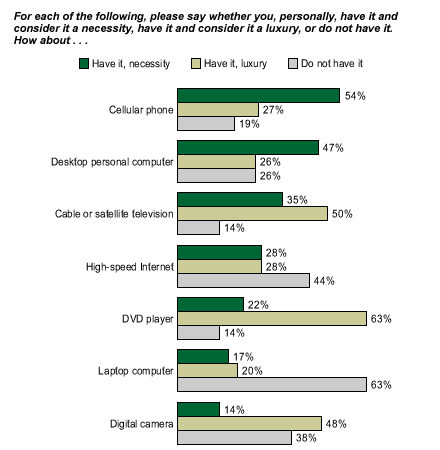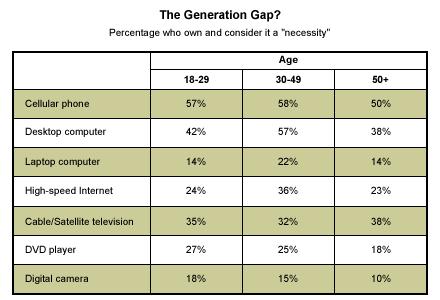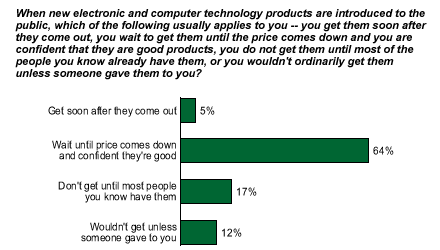With the recent explosion of high-tech consumer products that include everything from wireless laptops to iPods, Americans are confronted with options that they never even dreamed of a few decades ago. While the novelty of some of these tech products may be what initially attracted buyers, it appears that many are now considered essential parts of consumers' daily lives. Therefore, to effectively market these products, companies need to know the role these "gadgets" now occupy, not just in office buildings, but in consumers' homes.
A recent CNN/USA Today/Â鶹´«Ã½AV poll* asked U.S. consumers whether they personally have various high-tech products and whether they consider them luxuries or necessities. Some of the results aren't surprising; the ubiquitous cell phone is far more likely than the digital camera to be considered essential. What may be less expected are the impressively large numbers of consumers who now own these various products and consider them indispensable.
More than half of Americans say they have a cell phone and think of it as a necessity; and nearly half own a desktop computer and feel the same way about it. Sixty-three percent of Americans have DVD players and consider them a luxury, but even here, 22% have them and consider them essential.

Indispensable, That's What You Are…
What's additionally surprising is that younger Americans, who presumably grew up surrounded by high-tech products, are not more likely than older Americans to think of the products as essential. The prevailing image of older consumers as slow to embrace change and overwhelmed by the complexity of today's technology is to some extent outdated. Younger owners (those under age 30) of these products are not more likely to think of them as necessities; in several cases, they're actually less likely to deem them essential to their lives.
Perhaps that reflects younger Americans' belief that these products are all changing so rapidly that they will soon be made obsolete by still-newer emerging technologies. Thus, they may consider no product as truly "essential." Regardless, while cell phones and laptops may be thought of as "youth" products with a uniquely strong fit to their needs and lifestyles of younger consumers, the data show that clearly is not the case. They're now embraced every bit as strongly by 40- and 50-year-olds.

Innovators: The Prevalence of "Wait a Moment"
The same survey asked consumers what they usually do when new electronic and computer technology products are released. Not surprisingly, relatively few -- 1 in 20 -- report grabbing new products like these soon after they reach the market. As in other studies of early adopters, whether involving products or practices, true innovators have always represented a fairly small segment of the population. A majority of consumers, 64%, say they wait to buy until prices drop and they are confident the products are good. Seventeen percent say they usually don't get these products until most people they know have them, and 12% say they wouldn't get them unless someone gave them the products.
Overall, it appears most consumers are convinced that technology product prices will soon drop, because they typically do. In addition, waiting a bit may provide the reassurance, often through word-of-mouth from early buyers, that the product is actually capable of performing as promised.

Young Americans are not markedly more innovative; only 9% of 18- to 29-year-olds say they're usually among the first to buy these types of products. Like their older counterparts, most younger consumers (73%) rely on their firm belief that prices will always drop and technology needs to be "proven." Both young and old tend to be somewhat cautious.
Bottom Line
There are some important lessons here for marketers. First, consumers don't regard most of these high-tech goods as frivolous. They have an important -- indeed, vital -- place in the daily lives of today's consumers. That does not mean, of course, that purchase decisions are based purely (or even mainly) on rational considerations. Fashion, whether it's in a cell phone or laptop, is at least as important as function when considering "essential" products.
In addition, it's clear that today's technology has earned an important place in the homes (and hearts) of a wide spectrum of U.S. consumers. The market target, and the opportunity, is not merely focused on the young.
*Results are based on telephone interviews with 1,004 national adults, aged 18 and older, conducted Aug. 5-7, 2005. For results based on the total sample of national adults, one can say with 95% confidence that the margin of sampling error is ±3 percentage points.
